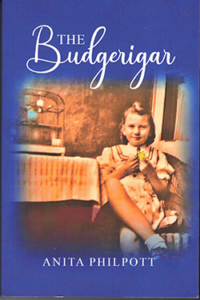The Budgerigar by Anita Philpott; Amazon Publishing (c) 2024; ISBN 9781917-054638; 377 pages including author’s note and acknowledgments; $14.99.

 SAN DIEGO — A budgerigar is a beloved type of parakeet, often kept in a cage. Some will fly outside their cage and return to it following their excursions. Author Philpott says a budgerigar is “a fragile but brave little bird who symbolizes the hope of the characters in the book.”
SAN DIEGO — A budgerigar is a beloved type of parakeet, often kept in a cage. Some will fly outside their cage and return to it following their excursions. Author Philpott says a budgerigar is “a fragile but brave little bird who symbolizes the hope of the characters in the book.”
In my own mind, two characters qualify in a metaphorical sense as budgerigars: Morrie, a Jewish boy whom we watch become a budding concert pianist, and Hilde, a Christian girl whom we admire as she develops into an artist. They are two sensitive and sensible youngsters.
They are forced to leave their adjacent nests. There is suspense whether they, like the budgerigar in the novel, will ever return.
In their childhoods, Morrie and Hilde lived next door to each other in Leipzig, Germany. They were best friends despite their different religious backgrounds. Their parents also got along well with each other.
However, they grew up during the Nazi era. In the horror of Kristallnacht, both of Morrie’s parents disappeared. Heidi’s family became his protector. However, a brutish Nazi who lived in their apartment building knew that Morrie was Jewish, so other living arrangements had to be made for him. Luckily, with his nearly white hair and fair complexion, he looked like an “Aryan” and so rescuers were able to mask his identity.
The fictional story primarily is narrated by Hilde, her mother Elsa, grandmother Oma, as well as by Morrie and his mother Clara. It provides us with portraits of a boy and girl who love each other innocently, and sketches of the sympathetic adults who take care of them.
Elsa and Oma might be described as Righteous Gentiles who risked their lives to protect Jewish neighbors. Elsa’s husband Raoul was more conflicted: a policeman who had been drafted by the Nazis, he had compassion for his Jewish neighbors but needed to comply with the antisemitic dictates of the Nazi regime. More peripheral characters were outright racists who took pride in hunting down Jews.
Clara’s concentration camp story is one with which Holocaust readers are familiar. She and her son had contrasting experiences. She was tortured. He lived under the Damoclean sword of potential discovery.
Author Philpott was born after World War II and raised in the United Kingdom. She doesn’t speak German. A story told to her by the daughter of a Nazi officer fired her imagination. Research and story-telling skills shaped it into an endearing novel in which you root for the main characters.
*
Donald H. Harrison is publisher and editor of San Diego Jewish World.